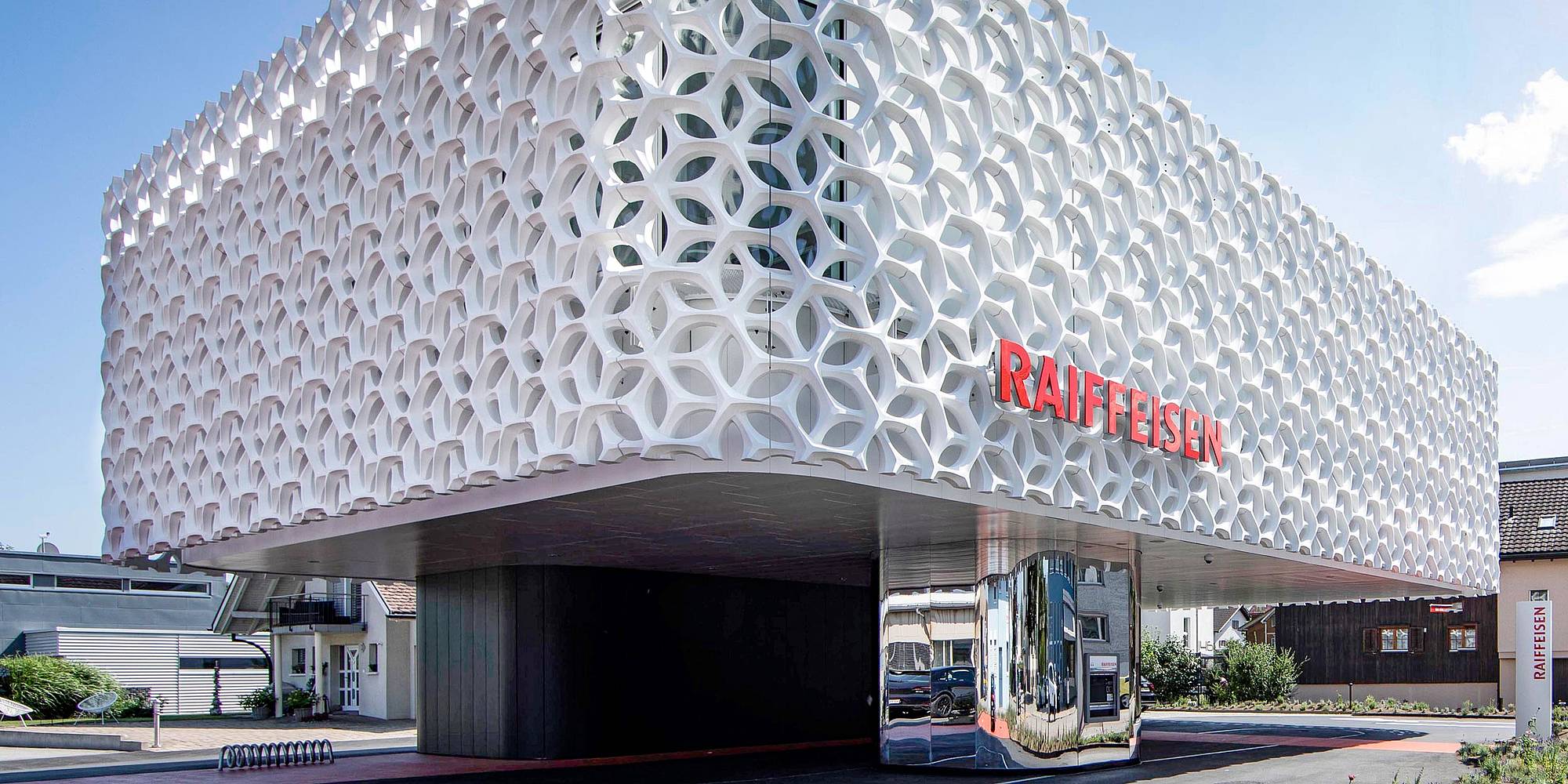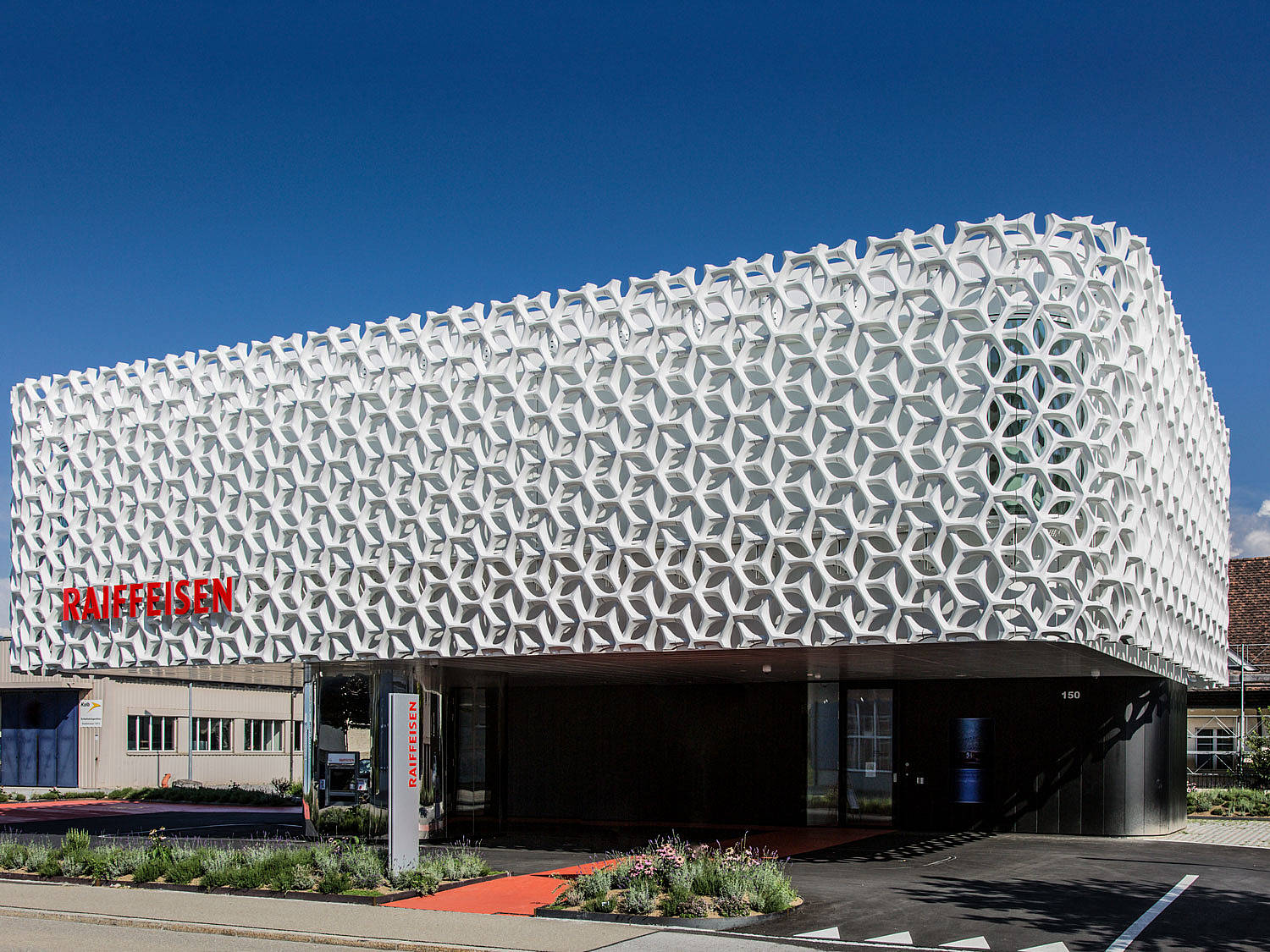Raiffeisenbank, Oberriet, Switzerland
The Raiffeisenbank in Oberriet stands out from its surroundings thanks to its special façade. Like a veil, 59 prefabricated fiberglass concrete elements enshroud the building - but they’re not just there for their looks.
The Oberriet branch of Raiffeisenbank sits enthroned over its neighborhood like a spaceship. Draped in a detailed white veil, the bank is guaranteed to turn heads.
Swiss architect Carlos Martinez is responsible for the design. He placed the rectangular upper building onto two bases, housing the entrance and the drive-thru ATM. Martinez was inspired by American drive-thrus, and his design is also reminiscent of architecture from the fifties and sixties.
The top floor of the building extends beyond the limits of its base, so it seems to float above the ground. The base is partially mirrored, allowing it to almost melt into its surroundings. “The whole bottom area is a high-end entrance, forecourt and parking lot in one, and continues the presentation with the chromed steel stripes inlayed into the asphalt,” says the architect.
Martinez designed this new place of business around the existing drive-thru counter. A red carpet guides visitors inside the bank, where offices and consultation rooms are housed on the top floor. “This consulting bank presents itself as an open, completely glazed cube that is zoned into individual pill-shaped areas only by glazed elements,” says the architect. At the touch of a button, the glazed elements can be shaded to guarantee customers’ privacy.
Externally, a web-like construction of concrete elements enshrouds the building. The façade takes up around 300 square meters and features a special design for a three-dimensional effect.

The design was implemented with the help of elastic textured formliners from RECKLI and threw up some challenges for the team. The formliners came from the UNIQUE series, for which custom formliners are produced to the architect’s and client’s individual specifications. To design the flat and curved surfaces of the façade, three custom formliners were required: one straight, one curved and one with a straight section as well as a curve. “As the curve is so large, it couldn’t be produced with just one element. We had to split it up into several pieces. The architect separated the façade into elements of equal size and designed the texture so that it could be reused after each element,” says Sven Kosjak, Operational Formliner Manager at RECKLI. To this end, three positive models were first produced in RECKLI’s in-house joinery workshop. These were then used to cast the formliners.
Precast curved elements have to be demolded carefully, especially elements with holes, such as those for the veil-like façade. “The elements always had to be demolded vertically. The curved elements for this project were a particular highlight, as the holes had to be realized conically to even allow demolding,” explains Kosjak. Markus Loacker, CEO of precast company CRE Panel, calls the demolding process one of the biggest challenges of the project. The big surface area of the mold made for big adhering tension, so the team had to be very careful.
To make things easier for CRE Panel, RECKLI cast the formliners in an unusual shape: instead of a flat formliner, the experts manufactured formliners with a V-shaped back despite their curved textured side. The formliners were then attached to supporting formwork for use in the precast plant. “These elaborate designs could not be realized with other molding materials and would not be possibly for economic reasons,” says Loacker.
The architect and client chose a fiberglass concrete for the façade, in brilliant white to really catch the eye. But this choice wasn’t just about the aesthetics. The concrete also filters the exhaust gases emitted by cars using the drive-thru. This is possible thanks to the titanium dioxide in the precast concrete elements. Under the influence of UV light, they develop a pollutant-replacing effect. This results in pollutants being deposited onto the concrete, where they can easily be rinsed off by water.
